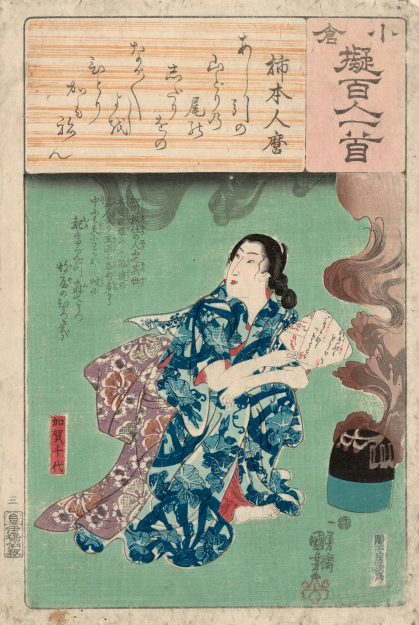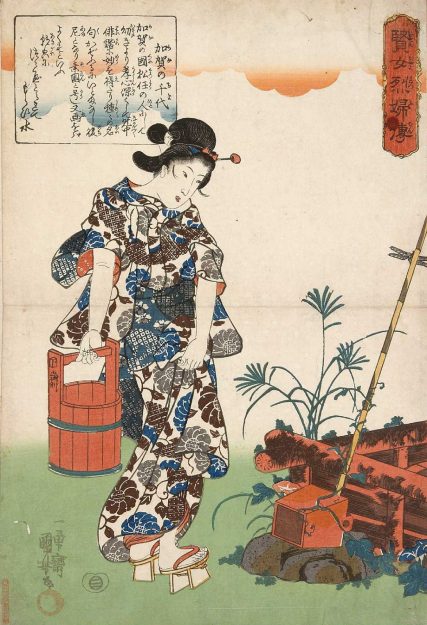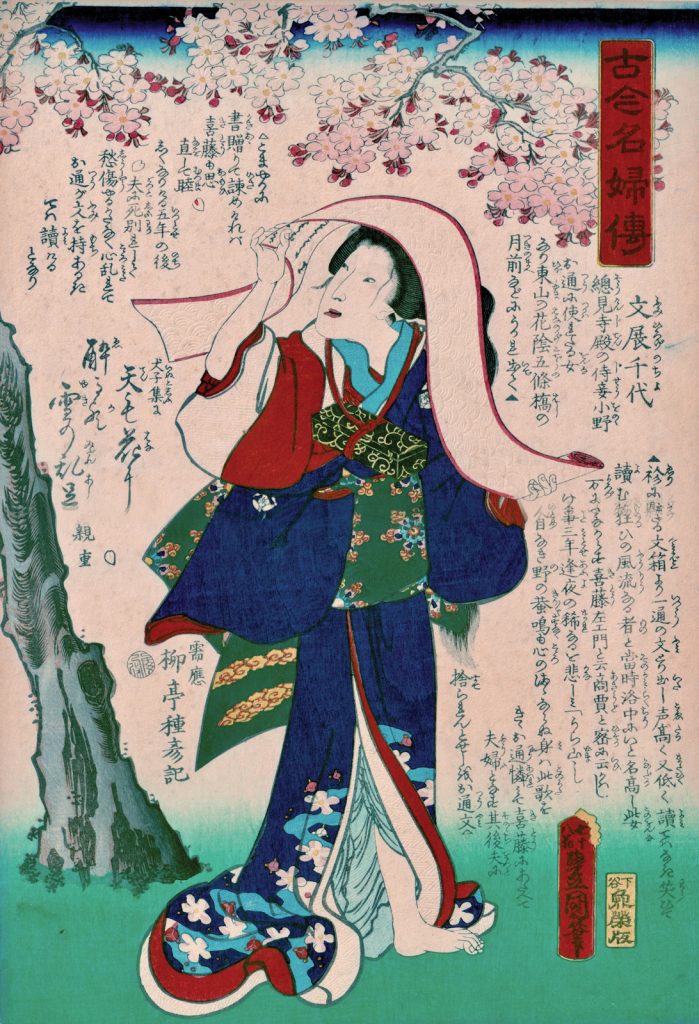The summer before I leave for Japan, I write this haiku:
This black pen
feels meaty
in a writer’s hand
Please don’t imagine that my decades of writing practice and Zen meditation have silenced or fully pacified the angry self-critics in my head. That’s not how things work. I’m just much better at managing those voices. After I write that haiku, my inner critics rise up and skewer me: What does a black pen have to do with this beautiful July day? Meaty? Give me a break. You think you’re a writer? Since when? Next it goes for the jugular, unadorned and raw. It leaps: I hate you; you’re stupid.
I’m at Vallecitos Mountain Retreat Center, a place I love. The sky is big; dragonflies flutter over the clear pool. I see the head of a beaver jutting out of the water on the far side. My legs are burning in the intense sun.
In that exquisite moment I let the critical voices pass. It’s okay, I tell myself. Try another. I do:
on my brown socks
a single black butterfly
flaps its wings
Don’t know where I’m going. But, okay, another:
a fire burns
across the valley
I want to go home
and another:
diving into
this ice-cold pond
my seventieth summer
I stand up on the deck, yank off my shirt and shorts, and do what I just wrote: enter the dark, frigid mountain lake fed by melting snow. I swim back and forth, gasping, panting, until I think, Nat, if you don’t stop now, you’re going to die.
I pull myself out, every pore alive. I think, But haiku are not so dramatic. They’re ordinary, subtle. I’m a bear grasping after a flower petal.
I look around, towel wrapped across my belly, hair dripping. I can’t take a step without stepping on a haiku. All around me, they’re waiting.
full moon
behind clouds
your lips on mine
For years I believed in Allen Ginsberg’s idea that “the little sensation of space, nothing less than God” is the only true haiku test. But what if God exists quietly, without sensation or without space? What if God takes many different forms?
Plus, the idea of a haiku leap becomes too materialistic, creates grasping in the writer—me—and in the reader. It’s easy to place too much value on that leap, to want something beyond what is. Trying too hard can kill the soul of what’s being written. A haiku is bigger than one thing; I tell myself, Don’t try to contain it. Yet, there is structure—three short lines. And within those lines there are multiple layers of resonances. Like the Basho frog haiku—it’s taken me years to feel its luminosity.
Some people argue that a haiku written in English should cleave to five, seven, five syllables; some say it should always refer to a season. Structure is good, important; but in this moment, I utter, Nah, as I yank on my pants and reach through the sleeves of my cotton shirt.
Sitting again on the ratty, half-collapsed, outdoor chair at the pond, I think, I’ve held myself hostage with Ginsberg’s ideas since 1974. What did Basho write for a student months before his death?
Don’t imitate me;
it’s as boring
as two halves of a melon

When I arrive home from the retreat, I run my finger along the spines in my bookcase. I have a vague memory that, years ago, right before I left for Japan for the first time in 1998, I bought a book called Chiyo-ni: Woman Haiku Master, edited by Patricia Donegan and Yoshie Ishibashi. But I dashed off on my travels and never read it.
I open it now and see that the two editors signed it and even added an inscription: “For Natalie. In appreciation of a fellow writer.” I turn the page, read further: “Chiyo-ni was born in 1703, seven years after Basho’s death. For decades she was considered equal to and the counterpart of Basho. More importantly, she was known and respected because she lived the Way of Haiku: aware and open to every moment.”
Buson, who began the Basho revival, [called] her work “woman’s haiku, weak and emotional.” Eventually, though, Buson couldn’t ignore her.
She was born in the small town of Matto, far in the north, with harsh winters that attuned her to seasonal changes. A Buddhist temple was nearby, with the ringing bells always in her ears. She wrote her first haiku at 6 and 7 years old. Stopping in the midst of play in a rice field, she gazed up at the birds in the autumn sky:
the first wild geese
coming
still coming
She was recognized for her early talent, and she had the opportunity to study with haiku masters. One of them, Shiko, stayed the night at her house, and in the morning he asked her to write a haiku on the iris:
Spring
remains
in the iris
Shiko also wrote one for Chiyo-ni as he looked at the flower arrangement in the family alcove:
no regret
to use the hibiscus’s shadow
as a rain shelter
Though Shiko and Chiyo-ni met only that one time, they wrote letters to each other. She often asked him to comment on and improve her haiku. When he died, she wrote:
sad, so sad
to miss the plum flower
before it fell
She became famous for her haiku—and her beauty. Yet Buson, who began the Basho revival during Chiyo-ni’s lifetime, denied her, calling her work “woman’s haiku, weak and emotional.”
Eventually, though, Buson couldn’t ignore her. He even asked her to write the introduction to his poetry collection, which was a great honor.
It is not clear that Chiyo-ni ever married, though some of her haiku show experience with romance and sensuality:
what shadow
can the star lovers meet in
before the moon disappears
till his hat
fades into a butterfly
I yearned for him
woman’s desire
deeply rooted—
the wild violets
eventually
whose skin will they touch—
rouge flowers
change of kimono:
showing only her back
to the blossom’s fragrance
She continued to study with other haiku masters. Though she was well-known, she stayed humble, often asking younger poets, even twenty years younger, for their critiques.
At one meeting of haiku poets in Kyoto, where she was the only woman in attendance, she surprised everyone by writing the best haiku about the full moon—conveying the impression of a full moon without mentioning it:
this evening!
since the crescent moon
I’ve been waiting
When she was in her thirties, a succession of tragedies wiped out her family, leaving her alone to manage their scroll-making business. Because of this, she couldn’t fully devote herself to writing haiku again until she was 50.
Much of her work celebrates everyday life outside the temple—yet she never lost sight of what is sometimes called sad beauty: the understanding and acceptance of impermanence.
At 52 she became a nun, but she did not live in a temple, as conventional nuns did. She lived at home but with the status of a nun, which gave her a certain freedom—and the rare privilege as a single woman to travel, meet male poets, and not be restricted by the normal social codes imposed on women.
She wrote her best haiku during this time. She wrote with prostitutes; created collaborative art with samurai; and wrote haiku as gifts for foreign visitors. Much of her work celebrates everyday life outside the temple—yet she never lost sight of what is sometimes called sad beauty: the understanding and acceptance of impermanence, that everything is transient.
clear water:
no front
no back
anyway
leave it to the wind—
pampas grass
She often painted illustrations of her haiku on the same sheets of paper, in a practice known as haiga, or haiku painting. In addition, she painted portraits, including one of Chigetsu, the most prominent woman disciple of Basho and a haijin—a master haiku poet living the Way of Haiku.
Book in hand, I lower myself into the old oak rocker I bought many years ago. Why hadn’t I ever heard of Chigetsu? Basho broke the old paradigm and created a Way, a practice, so he should be recognized. But there were women practicing that Way too.
Until I encountered Donegan and Ishibashi’s book, no whiff of that practice had ever passed through most of the books I read.

Four women poets were especially close to Chiyo-ni: Kasenjo, Shisenjo, Suejo, and Karyo-ni. Suejo was Chiyo-ni’s main disciple and closest companion.
As she grew older, Chiyo-ni’s health suffered:
my energy
can only defeat a butterfly
this spring morning
She left behind several death poems, including these:
clear water is cool
fireflies vanish—
there’s nothing more
I also saw the moon
as for this world—
ah—good-bye
When she died at 72, she, like Basho and Buson, was surrounded by her close haiku friends and disciples, especially Suejo.
I knew when I listened to Ginsberg, so many years ago, that women were involved but not mentioned. I am not a patient person, but in this one way I am—I listen to the boys and wait with certainty that the women will be revealed. They have to—they were there too.
More by Chiyo-ni:
morning glory—
the truth is
the flower hates people
moonlit night—
a cricket sings
out on a stone
When I talk with Mitsue on the phone and tell her I found this woman haiku writer, she says, “I think we studied Chiyo-ni in school, but no one said she was a woman.”
she also cups
the spring water
for her travel writing brush
twilight
is left
in the maple leaves
unfinished dream—
a chrysanthemum blooms
in the tatami room
♦
Excerpted from Three Simple Lines: A Writer’s Pilgrimage into the Heart and Homeland of Haiku by Natalie Goldberg. Reprinted with permission from New World Library.
Thank you for subscribing to Tricycle! As a nonprofit, we depend on readers like you to keep Buddhist teachings and practices widely available.
